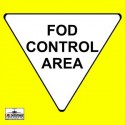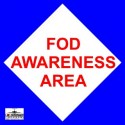Compliments of U.S. Air Force “Flying Safety” Magazine
You all have seen or heard of “The Right Stuff.” How about The Right Part? We have too many incidents where using the wrong hardware resulted in aircraft damage. Never forget the few seconds you save will cost a whole lot more when you redo the work. Isn’t “Excellence in all we do” one of our core values?
Lost Nut = Stuck Throttle
A T-38 was supposed to be flying a student-training sortie but unfortunately came home early with a throttle stuck at 95 percent. Once safely on the ground, the maintenance inspection found a 1/4-inch nut lodged between the throttle control box and the main fuel control input shaft. A 1/4-inch “body-bound” bolt was also found loose in the engine bay. The cause of the stuck throttle was found, but how did it get there? In this case, the engine had undergone maintenance 26 flight hours prior to the event for an ice ingestion engine stall. The technicians had to split the compressor case to inspect for compressor damage. On engine reconstruction, the compressor case was reattached and the self-locking nuts torqued to 44-48 inch pounds IAW T.O. 2J-J85-116- 6. The nut that attached itself to the fuel control had no self-locking ability. Do you know how to tell if a nut’s self-locking capability is still there? Evidently the technician in this case didn’t, or the story wouldn’t be printed here. If you are curious about or unaware of the rules for self-locking hardware see T.O. 1-1A-8 for the full story.Flight Controls Split
A KC-135 maintenance crew had started their post flight inspection when the aircraft flaps suffered a split flap problem and damage that wasn’t flight related. Initial investigation by the maintenance impoundment team focused on a failed flap gearbox. The team removed the damaged flap and aileron, and as they removed the outboard torque tube from the gearbox, they found the torque tube separated from the center splined shaft. This little problem would have caused the initial split flap problem. Further investigation revealed that the self-locking nut and washer that was supposed to hold things together were missing. Now how could that have happened? In this case we don’t know and will never know. There was no documentation of any flap maintenance within the last 90 days. Self-locking nuts don’t normally come off all by themselves, so make sure they actually are self-locking!
Which Way Does The Safety Wire Go?
At one time or another all of us can say we had to stop and think about which way the safety wire goes when securing multiple fasteners. In this case it caused a C-130 a little gear problem, it wouldn’t come down. The crew was able to get the gear down and safely land at home station. What happened? Maintenance found the right forward main gear vertical torque shaft quick disconnect (QD) coupling nut disconnected. Not a good thing when flying, except maybe when ground flying. How can a safety wired QD come apart inflight? When the QD came apart the strut wedged itself against other components. Causing the gear to stick. Now the QD itself was not damaged and the safety wire used to secure the QD was still present, but broken. The QD was safety wired by .032 safety wire using the single strand method. Another factor was that this was the first flight after an ISO inspection. The ISO inspection work cards require the vertical shaft to be disconnected, inspected, lubed and reconnected. The work cards even refer the technician to T.O. 1C-130H-2-32JG-10-1 for proper procedures. Now pages 2-199/2-206 specify that the QD coupling nut should be applied hand tight and “then install two strands of safety wire.” How many were actually installed on the mishap aircraft? The T.O. even has a picture that shows the exact safety wire routing for the QD. Immediately below the procedure for the QD is a procedure for those struts with a coupling that has four bolts and nuts instead of the QD. The procedure for safety wiring this type of connector…the single strand method. An inspection of the fleet found one other connector improperly safety wired. Bottom line of all this? Make sure when you are doing maintenance and there are options on how to safety wire a connector, you utilize the right safety wire procedure. If you are ever in doubt, ask your supervisor for help.Another Case Of Non Self-Locking
This time a KC-10 came home with a number 1 engine anti-ice valve problem. Upon landing the maintenance team found the over pressurization blowout door on the cowling opened and separated from the aircraft, one of the N1 fan blades bent 90 degrees outward and several large sections of abraidable seal material missing. In addition, the team found a section of the anti-ice duct unattached due to a broken clamp. The team removed the engine and sent the broken clamp off for analysis. The abraidable material was within limits, but they fixed it anyway, and the fan blade was changed. The cause of the fun and games? The self-locking nut on the bleed air clamp was useless as far as self-locking goes. It had been loosened and tightened numerous times and had an immeasurable amount of running torque. That means the dang thing was stripped out. The clamp had broken at the U channel area where the clamp retains the duct, and had failed from fatigue. How many times can you reuse a self-locking nut in a critical area of the aircraft? If you don’t know, then go to your tool room, find T.O. 1-1A-8, section 5-29 and read the guidance on self-locking nuts and don’t forget the caution. Maybe this is a topic for the next safety day?
Self-Locking Fasteners Can Drive You Nuts!
February 25, 2011 by



